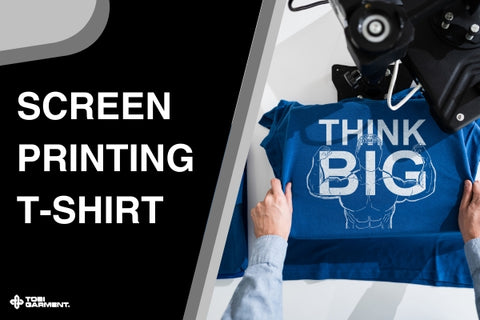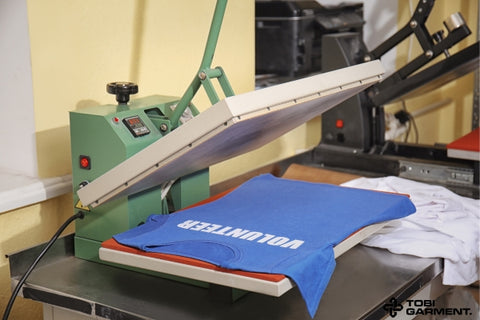
In this comprehensive guide, we'll cover the fundamentals of screen printing, the best equipment and materials to use, step-by-step instructions for screen printing t-shirts, and creative design ideas to make your shirts stand out. By the end of this article, you'll have the knowledge and confidence to start screen printing your own custom t-shirts.
Understanding the Basics of Screen Printing
What is screen printing?
Screen printing, also known as silk screening, is a printing technique that uses a mesh screen to transfer ink onto a substrate, typically fabric like t-shirts. The process involves creating a stencil of the desired design, which is then used to guide the ink through the screen and onto the t-shirt.
How does screen printing work?
The screen printing process involves several key steps:
- Creating the design: The first step is to create the artwork or design that will be printed on the t-shirt. This can be done using design software like Adobe Illustrator or Photoshop.
- Preparing the screen: A mesh screen is coated with a light-sensitive emulsion and exposed to light. The areas of the screen that are exposed to light harden, while the areas covered by the design remain soft.
- Washing out the design: The screen is washed with water, which removes the soft emulsion and leaves behind the hardened stencil of the design.
- Applying ink: The screen is placed on the t-shirt, and ink is applied to the top of the screen. A squeegee is used to push the ink through the mesh and onto the fabric.
- Curing the ink: The printed t-shirt is then heated to cure the ink, which helps it adhere to the fabric and become durable.
Read more: A Beginner's Guide to Screen Printing on Garments
Key equipment for screen printing
To start screen printing, you'll need the following equipment:
- Screen printing press: This is the main piece of equipment that holds the screen and t-shirt in place during the printing process.
- Screens: These are the mesh frames that hold the stencil design.
- Squeegees: Used to push the ink through the screen and onto the t-shirt.
- Ink: There are several types of ink to choose from, including plastisol, water-based, discharge, and pigment inks.
- Exposure unit: Used to expose the screen with the design.
- Flash cure unit: Used to quickly dry the ink between colors or at the end of the printing process.
How to Screen Print T-Shirts
Gather Your Supplies
Before you start screen printing, make sure you have all the necessary supplies:
- T-shirts: Choose high-quality blank t-shirts made from 100% cotton or a cotton/polyester blend for best results.
- Screens: Select screens with a mesh count appropriate for your design and ink type.
- Squeegees: Choose a squeegee with a durometer (hardness) suitable for your ink and design.
- Ink: Decide on the type of ink you'll be using, such as plastisol, water-based, discharge, or pigment.
- Emulsion: Used to create the stencil on the screen.
- Exposure unit: Needed to expose the screen with the design.
- Flash cure unit: Helps dry the ink between colors or at the end of the printing process.
Prepare Your Design
The next step is to create your design and prepare it for screen printing:
- Design your artwork: Use design software like Adobe Illustrator or Photoshop to create your design. Keep in mind that you'll need to create a separate design for each color in your print.
- Separate the colors: If you're using multiple colors, separate each color into its own layer or file. This will allow you to create a separate screen for each color.
- Create a film positive: Print your design onto a transparent film, which will be used to expose the screen.
- Coat the screen with emulsion: Apply a light-sensitive emulsion to the screen and allow it to dry in a dark room.
- Expose the screen: Place the film positive on the screen and expose it to light. The areas covered by the design will remain soft, while the rest of the screen will harden.
- Wash out the design: Wash the screen with water to remove the soft emulsion, leaving behind the hardened stencil of your design
Set Up Your Screen Printing Press
Now it's time to set up your screen printing press:
- Secure the screen: Place the screen on the press and secure it in place.
- Position the t-shirt: Lay the t-shirt flat on the printing platen and secure it with adhesive.
- Align the screen: Position the screen over the t-shirt and ensure that the design is aligned correctly.
Apply Ink
It's time to start printing! Follow these steps to apply the ink:
- Flood the screen: Use the squeegee to apply a generous amount of ink across the top of the screen.
- Pull the ink: Pull the squeegee down across the screen, applying firm pressure. This will push the ink through the mesh and onto the t-shirt.
- Flood the screen again: Repeat step 1 to apply more ink to the top of the screen.
- Pull the ink again: Repeat step 2 to push the ink through the screen and onto the t-shirt.
- Repeat for each color: If you're using multiple colors, repeat steps 1-4 for each color, making sure to align the screens correctly.
- Flash cure the ink: Use a flash cure unit to quickly dry the ink between colors or at the end of the printing process.
- Cure the ink: Once all colors have been printed, cure the ink according to the manufacturer's instructions, typically using a conveyor dryer or heat press.
Read more: Screen Printing Hoodies: A Step-by-Step Tutorial for DIY Enthusiasts
Best Screen Printing Ink for T-Shirts
There are several types of ink to choose from when screen printing t-shirts:
Plastisol ink
Plastisol ink is the most commonly used ink for screen printing t-shirts. It's durable, opaque, and easy to work with. Plastisol ink requires heat to cure, typically around 320°F (160°C).
Water-based ink
Water-based ink is a more environmentally friendly option that produces a softer feel on the t-shirt. It's best suited for lighter-colored fabrics and requires lower curing temperatures, typically around 250°F (120°C).
Discharge ink
Discharge ink is used to remove the dye from the t-shirt fabric, allowing the ink to be printed directly onto the white or light-colored fabric. This results in a softer feel and a more vintage look.
Pigment ink
Pigment ink is a type of water-based ink that is suitable for printing on dark-colored fabrics. It produces a matte finish and requires lower curing temperatures compared to plastisol ink.
Read more: Everything You Need to Know About Screen Printed Shirts
T-Shirt Design Ideas
When it comes to screen printing t-shirts, the design possibilities are endless. Here are some popular design ideas to inspire you:
Simple designs
Simple designs with bold text or graphics can make a strong statement. These designs are often easy to print and can be applied to a wide range of t-shirt colors.
Typography designs
Typography designs featuring creative lettering or calligraphy can add a unique touch to your t-shirts. These designs work well for slogans, quotes, or brand names.
Graphic designs
Graphic designs featuring illustrations, icons, or patterns can add visual interest to your t-shirts. These designs can be simple or complex, depending on your skill level and the number of colors used.
Photorealistic designs
Photorealistic designs featuring photographs or detailed illustrations can create a stunning effect on t-shirts. These designs often require more screens and a higher level of skill to print accurately.
Read more: How to Create T-Shirt Designs Without Drawing
Custom designs
Custom designs created specifically for your brand or event can help your t-shirts stand out from the crowd. These designs can incorporate your brand colors, logo, and unique elements to create a cohesive and memorable look.
FAQ
Q: What is the best mesh count for screen printing t-shirts?
A: The best mesh count for screen printing t-shirts depends on the type of ink and design you're using. Generally, a mesh count between 110-156 threads per inch (tpi) is suitable for most t-shirt printing applications.
Q: How long does it take to screen print a t-shirt?
A: The time it takes to screen print a t-shirt can vary depending on the complexity of the design and the number of colors used. A simple one-color design can be printed in a matter of minutes, while a more complex multi-color design may take several hours to set up and print.
Q: Can I screen print on dark t-shirts?
A: Yes, you can screen print on dark t-shirts, but you may need to use a different type of ink or technique. For example, discharge ink can be used to remove the dye from the fabric, allowing the ink to be printed directly onto the white or light-colored fabric. Alternatively, you can use a white underbase to create a bright, opaque print on dark fabrics.
Conclusion
Screen printing is a fun and rewarding hobby that allows you to create custom t-shirts with your own unique designs. By following the steps outlined in this guide and experimenting with different techniques and materials, you can produce high-quality screen printed t-shirts that showcase your creativity and style.
Remember to always prioritize safety when screen printing, use proper ventilation, and follow the manufacturer's instructions for all equipment and materials. With practice and dedication, you'll be able to master the art of screen printing and create t-shirts that you can wear with pride or sell to others.
Read more related posts from Tobi Garment:
- How to Create Stunning T-Shirt Mockups: A Comprehensive Guide
- Top Hoodie Print Placements: Make Your Hoodie Stand Out
- Building Your Own DIY Dry Box: A Step-by-Step Guide
- Eco-Friendly Screen Printing: Your Guide to Sustainable Style



